The aft section of second Type 26 Frigate HMS Cardiff was rolled out of the build hall earlier today.
The forward ‘superblock’ will be joined to the aft ‘superblock’ soon. The mast will also soon be added to the vessel.
Here’s some footage.
Drone footage shows the immense scale of the vessel as it becomes part of the Glasgow skyline. In a while it'll be moved onto a barge and lowered into the river before heading to Scotstoun to be fitted out. pic.twitter.com/Pf5aYB732A
— George Allison (@geoallison) July 2, 2023
The Type 26 represents the future backbone of the Royal Navy and eight of the class are planned, starting with HMS Glasgow. The eight ships will replace the eight dedicated anti-submarine Type 23 frigates which will reach the end of their active lives by the mid 2030s. In addition to the Clyde built Type 26, five Rosyth built Type 31 general purpose frigates are intended to replace the general-purpose Type 23s currently in service and also coming towards the end of their long careers.
More information on the drone footage
We have verified the drone footage as being legal, as we always do, but we thought it best to include this section.
In the United Kingdom, drone flights are managed by the Civil Aviation Authority (CAA), and adherence to these rules is essential to ensure the legal operation of drones. For the footage captured, the operator used a sub-250g drone.
Under UK legislation (Article 95 of the Air Navigation Order 2016), drones of this weight are exempt from minimum distance requirements from people, vessels, vehicles, and structures. Despite this exemption, the operator maintained a prudent distance from the shipyard and the ship, focusing the drone’s flight path over the river and nearby grassland as an added safety measure.
In addition to these legal requirements and precautions, the operator also followed several best practice guidelines to ensure the safe and legal operation of the drone. The operator was registered with the CAA and had secured the necessary Operator ID for the drone. Thorough pre-flight checks were conducted, including checking the weather for safe flying conditions and reviewing Notices to Airmen (NOTAMs) for any temporary airspace restrictions. During the flight, the operator actively monitored for nearby aircraft to avoid any risk of interference.
These thorough measures, while not all mandated by law, demonstrated the operator’s commitment to safety and regulatory standards, further ensuring the legality and safety of the drone flight.




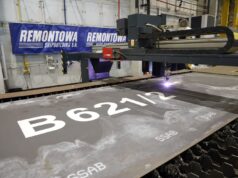
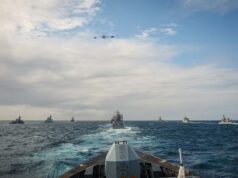



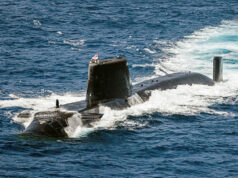

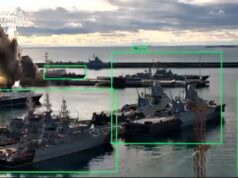
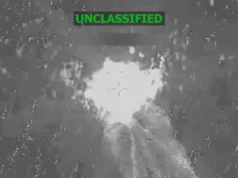

Just comparing her to the same stage when Glasgow was rolled out 2 years ago. Is it me or does the rear end look a lot less finished than when Glasgow was rolled out. Far more red Primer and the back acoustic section isn’t visible.
Great pictures George as always.
Indeed, it is a lot less finished – why?
They need the indoor spaces for Belfast and Birmingham ?
Possibly after the build of Glasgow it was determined that certain stages of the build could be done differently/more efficiently.
Or, it is just as finished as it needs to be, in ways that need to be, leveraging lesson learned from hull number 1
Actually impressed that there were active operations on a Sunday. Typical, or has someone increased the pace dial? ,🤔
If I were a betting man I’d guess they have turned the dial up, but that can only happen if the treasury has sped up the staged payments.
One of the major criticisms of the T26 build has been the snails pace of work which was caused by how the treasury pays its bills.
On the other hand it could just be that the weather is lovely, they knew George was out with his drone and they are all on Double Time.
😁
They’re are now employing Ferguson marine to carry out work which suggests the dial has been turned up.
There are a range of speeds marked on the engine telegraph:-
Full Ahead
Cruise
Dead Slow
Ferguson Ferry Production Speed
Stopped
Astern
Ferguson Ferry Speed Rework
Full Astern
That might suggest the dial has been turned down below zero?
😁
Things are clearly a bit behind.
The best day to do these mega operations is a day not too much is going on.
That way it doesn’t impact all the other activities in the yard as the area of the shift will be closed to vehicular and foot traffic for safety reasons.
Quite a plausible alternative explanation.
In terms of paintwork it might just be the case that they are confident of making use of the remaining summer months to finish the work outside, freeing up the shed for Belfast.
Painting outside in Summer in Scotland, not good. I once tried touching up the paint on my 1st mini in September. It looked like it had been micro pebble dashed ! Midges in the paintwork 🤭
More about humidity and salt control than anything else.
If you are painting outdoor it is pretty inevitable that you end up with salt inclusions in the paint.
Bearing in mind how the 2 hull sections Of Glasgow looked on rollout, are you surprised by the state Cardiffs stern is in ?
Yes.
They are clearly behind schedule and to make sure this build did not impede the next two: it had to be moved out of the shed.
TBH I’d reckon Cardiff’s stern section is far more complete now than HMS Glasgow was as it should have the main gearboxes already fitted (after the stern and bow sections were fully integrated, Glasgow had to have its hull cut open during late summer/autumn’21 to have the delayed gearbox installation done)
Where’s the missin bit?
That’s the “stealth” section.. 😆
Due to treasury restrictions, she is fitted for, but not with a middle bit!
Typical!😥
It’s Glasgow so the middle bit is taken away at night and stored separately in case anyone try’s to Knick it. 😀
Solved!😄
😄
Love it Jim! Aye, you’re sounding like a bit of Billy Connolly there!
How refreshing. The frigate with the hole.🍩Couldn’t find a mint !!!
This isn’t exactly good news, when you do the maths this is 2 years and 2 months since HMS Glasgow was at the same stage !
I know they are hampered by the way they are having to build them, which is in 2 halves, then joined together, masts and funnel added and then barged out.
But it is incredibly slow progress, the T45 are bigger and we’re mega block built and assembled outside on the slipway and on a yearly drumbeat
I just hope the new Frigate shed gets them back up to speed.
I think the pace is picking up, construction on Belfast started 2 years ago. First steel was cut for Birmingham in April this year, lets hope those new buildings will create more capacity in a few months time.
Can’t understand the logic of not painting the external hull while it’s indoors it would have been completed in less than a week in controlled conditions ,seems todays planners don’t know what they are doing
They are about to do a shed load of welding midships. After that it will need blasting either side of the welded area and the paint system applying which is probably a 3 coat above the waterline and 4 or 5 coat below the water line.
For the below the waterline especially you have max/min times between coats which for the minimum time is measured in a hours to a couple of days. Once you start application you dont want to stop. Total time to apply a 5 coat system probably 72 hrs. They will plastic sheet the external hull anyway to paint it to ensure humidity and temp are maintained within the paint limits. If you mess it up by exceeding the temp, humidity or overcoat times, especially with Silicon foul release paints the Paint Manufacturer Onsite Rep will tell you that you have to start again from scratch by re blasting the entire hull. He wont guarantee the coating life otherwise which should be at least 5 years. Total reapplication is an expensive and time consuming job so you need to get it right first time.
For the Grey again better in one go per coat so it doesnt look blotchy and you can more importantly ensure that you get uniform Wet Film Thickness over all of the hull without any pinholes in the paint coating.
In the yard I work in we can do one above waterline coat on a VLCC Tanker Port and Stbd front to back in around 8-10 hrs with our painters. Once they get going its remarkably quick…although the weather is in our favour stand fast airborne sand and dust!
Below waterline silicon is a major pain . It has strict application criteria so we normally apply it at night/early morning when its cool and less humid. Even then we mix the paint ( Its a 2 part paint) in an AC controlled container and it has a max application/worktime of less than an hour. We usually have 6 spray guns in massive cherry pickers going to get it on all fed from a centralised paint hopper.
All you ever wanted to know about Painting but where afraid to ask is contained in the MOD Document ” WARPAINT” at the link
I know exactly how hull painting is done with prefabricated assemblies , I worked 3 years in Hyundai in South Korea where they churn out ships of all sizes and types like a production line , many lessons could be learned from there including warship building indoors where you should maximise your completions including paint systems
Exactly so.
There is fully optimised efficiency – climate controlled build halls.
And there is make-do by using plastic sheeting round scaffold which never works as well.
Unfortunately one of the banes of the British ship building industry has always been an unwillingness to invest in infrastructure that creates efficiency and was one of the three nails in the ship building coffins and was actually the first one ( it was the trigger to the loss of market share in 1945-1955, due to an inability to meet increased demand)..the second was labour relations (1960s to 1980s) and the third insurmountable one was labour costs.
Exactly everything was to suit the yard owners who would not invest in infrastructure or equipment as there was no guarantee of continuous work and hence the whole industry collapsed due to overseas competition , the yards at the moment are still in catch up mode to be more efficient and able to compete in the open markets
Another issue is the size and location of the remaining British yards…. They are smaller and in more cramped locations generally that the Asian yards, which just seemed to be much larger/purpose built for the larger ships of today…
Maybe from this photo we can imagine the potential length of a “stretched T26” T83 here if another section was added in the gap?
We don’t need a stretched version for AAW. Do away with the mission space and add loads of vls.
T26 AAW is a no brainer and we should leverage the hull to maximum potential by ordering another 8. This would give us a very good escort fleet and allow us to fully kit out the CSGs and LSGs with required high end escorts it also extracts maximum value out of this design.
The ships body of the BAE AAW proposal for the RAN does look a bit like a join of the front end of Australian T26 with the mid-back end of the T45, minus the mission space and muscled up with lots of vls. They seemed to have knocked that up on the quiet. And I’d imagine with a much heavier tonnage the ship will need an extras GT to push it along?
Posters on here with knowledge of Naval Architecture have explained why a stretched T26 won’t work.Whatever the T83 ends up being the consensus is it will not be based on T26.
Will the “real T83” please stand up! 😁
Many thanks for the up date George. Moving ahead.